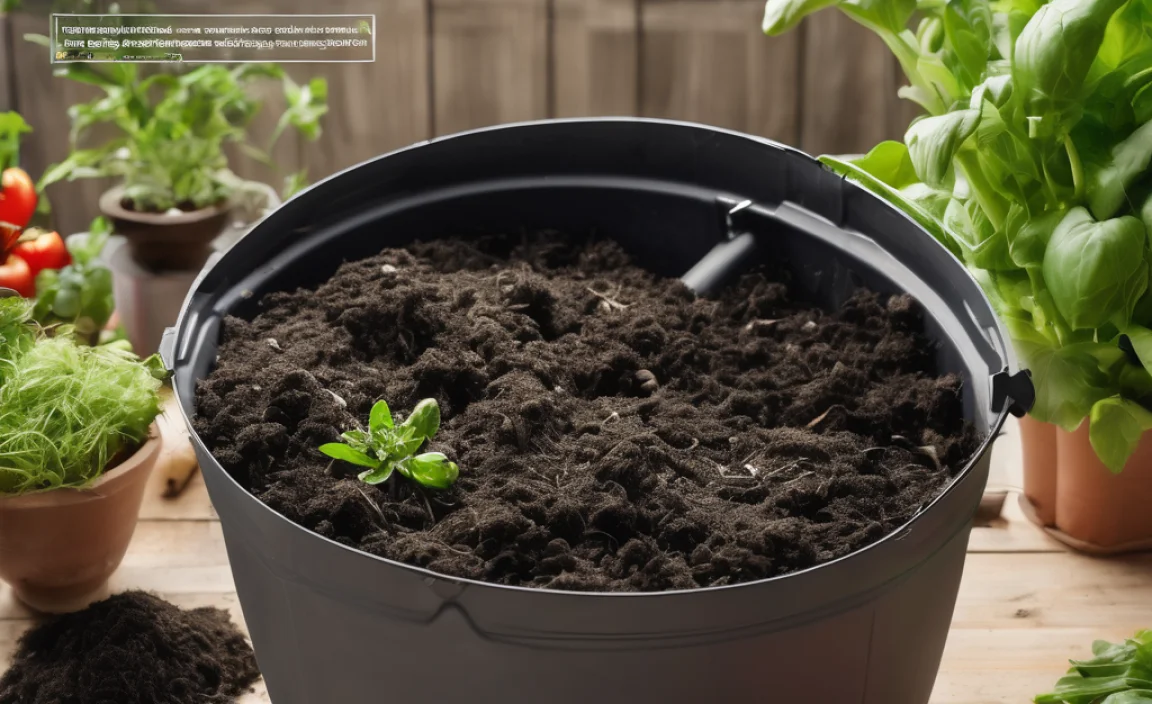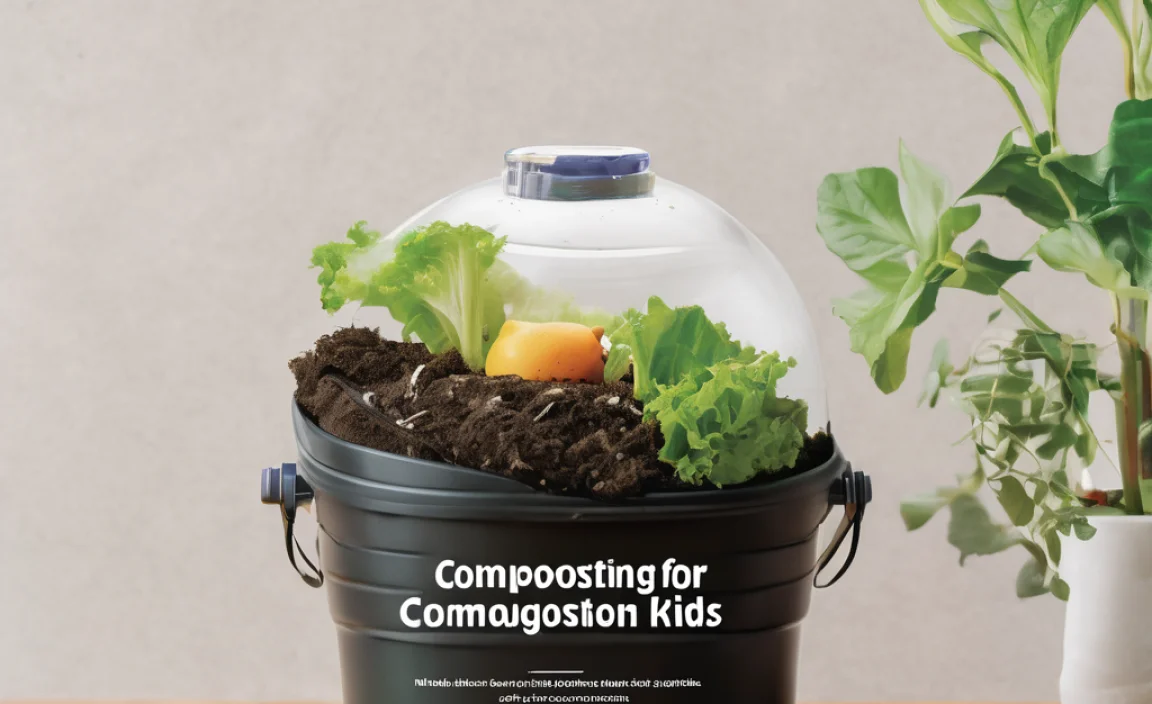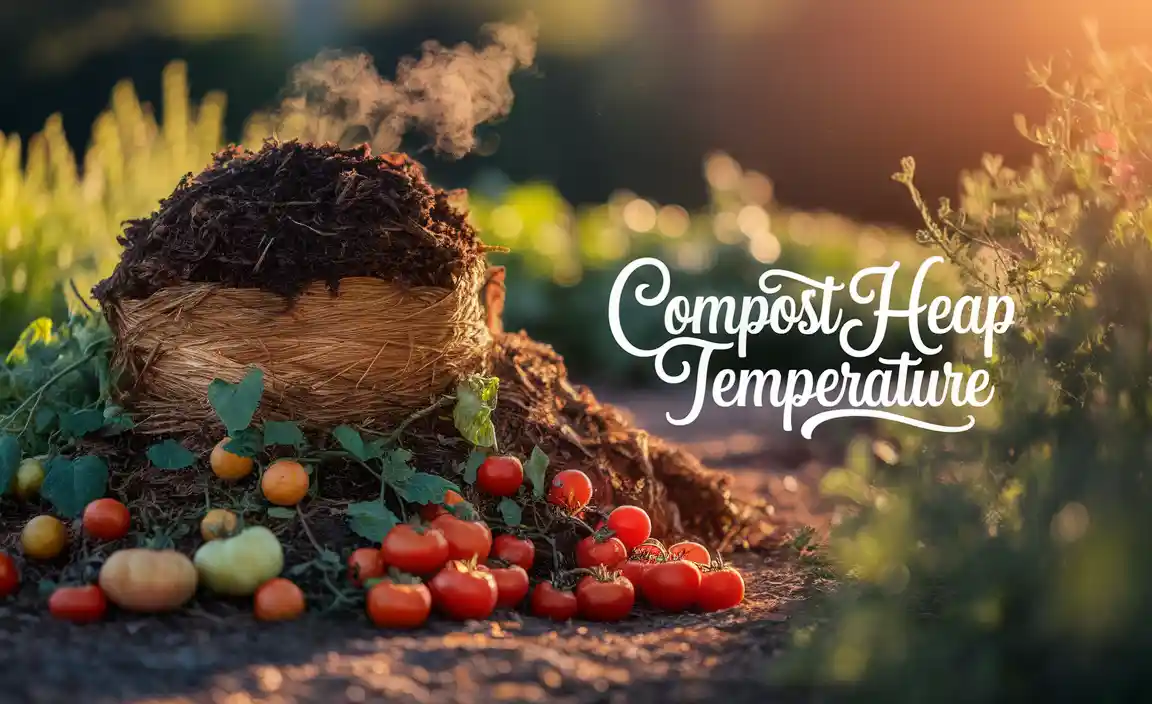Ever stared at your garden bed, wondering what’s the best stuff to enrich your soil? It’s a common question when you’re aiming for a thriving garden. You see bags of “topsoil” and “compost” at the garden center, and they look pretty similar. But are they the same? Do they do the same job? This guide will walk you through the differences, showing you exactly when and why to choose one over the other. Let’s dig in!
Compost vs Topsoil Comparison: Your Essential Guide to Healthier Gardens
Hey there, garden enthusiasts! Troy D Harn here, ready to tackle another common gardening puzzle. You’re likely standing in a garden center or staring at a muddy patch in your yard, thinking, “What’s this stuff, and what does it do for my plants?” It’s easy to get confused between compost and topsoil. They both sound good for your garden, right? But understanding the difference is key to giving your plants exactly what they need to grow big and strong. Think of it like choosing the right fuel for your car – you want the best for a smooth ride! We’ll break down what each one is, how they’re made, what they’re best used for, and how to tell them apart. By the end, you’ll be a pro at soil amending! Ready to give your garden the best chance to flourish?
What is Topsoil?
Topsoil is essentially the uppermost layer of soil found in nature. It’s the part of the earth’s surface that’s been developed over a long time through the breakdown of rocks and organic matter. Think of it as the Earth’s natural skin. When you buy topsoil from a store, it’s usually screened and blended to create a uniform product. It typically contains minerals, some organic material, and a bit of sand, silt, and clay. Its main job is to provide a base structure for plant roots to grow in and to hold moisture and nutrients.
Key Characteristics of Topsoil:
- Natural Origin: Harvested from the top layer of the ground.
- Mineral-Rich: Contains essential minerals from rock decomposition.
- Structure: Provides a stable medium for root growth.
- Variable Composition: Can vary greatly depending on the source, but often blended for consistency when sold.
- Less Organic Matter: Generally has less decomposed organic material compared to compost.
Because it’s a fundamental part of the earth’s surface, topsoil is the foundation for many planting projects. It’s often used to fill in holes, build up garden beds, or as a base layer for lawns. While it has nutrients, they are often bound up in the mineral component and take time to become available to plants.
What is Compost?
Compost is created through a process called decomposition. It’s made by breaking down organic materials like kitchen scraps (vegetable peels, coffee grounds, eggshells), yard waste (leaves, grass clippings), and other biodegradable items. This breaking-down process is managed, often by beneficial microbes, fungi, and bacteria, until the material turns into a dark, crumbly, nutrient-rich substance. It’s like a superfood for your soil!
Key Characteristics of Compost:
- Man-Made (or Managed Natural): Created through the controlled decomposition of organic matter.
- Organic Rich: High in decomposed organic material.
- Nutrient Dense: Packed with readily available nutrients for plants.
- Beneficial Microbes: Teeming with life that helps improve soil health.
- Improves Soil Structure: Acts as a soil conditioner, improving drainage and aeration.
Compost is a fantastic soil amendment. It doesn’t just add nutrients; it actively improves the physical properties of your soil. It can make dense clay soil looser and better draining, and it helps sandy soil retain more moisture and nutrients. It’s often called “black gold” by gardeners for good reason!
Compost vs Topsoil: The Big Differences
So, how do these two stack up against each other? While both are beneficial for your garden, they serve slightly different primary purposes. The biggest difference lies in their composition and what they bring to your soil.
Topsoil is primarily mineral. It’s the stuff that makes up so much of our planet’s surface. It provides bulk and structure. Compost, on the other hand, is almost entirely organic. It’s the result of decomposition and is packed with the building blocks that plants can easily use, plus all the good microbes that make soil healthy.
Here’s a table to help visualize the main distinctions:
| Feature | Topsoil | Compost |
|---|---|---|
| Primary Composition | Mineral, with some organic matter | Decomposed organic matter |
| Nutrient Availability | Nutrients are present, often in mineral form, released slowly. | Rich in readily available nutrients for plants. |
| Soil Improvement | Provides structure and base for growth. Can be heavy or dense. | Improves drainage, aeration, water retention, and soil structure. |
| Microbial Activity | Variable, generally lower than compost. | High; teeming with beneficial microorganisms. |
| Cost | Generally less expensive per cubic yard than compost. | Often more expensive per cubic yard than topsoil. |
| Primary Use | Filling, leveling, base layers for lawns and beds. | Amending existing soil, enriching planting holes, top-dressing. |
Think of it this way: topsoil is like the foundation of a house, providing solid ground. Compost is like the vitamins and supplements you add to your diet to make sure you’re getting all the good stuff your body needs to thrive. You need both for a well-rounded outcome!
When to Use Topsoil
Topsoil is your go-to when you need to build, fill, or establish a basic foundation for your garden or lawn. It’s about adding volume and structure where it’s lacking.
Common Uses for Topsoil:
- Leveling Uneven Ground: If you have dips or holes in your yard, topsoil is perfect for filling them in and creating a smooth surface.
- Building Raised Garden Beds: When creating new raised beds, topsoil often forms the bulk of the filling material. You’ll typically mix in compost or other amendments for better fertility.
- Lawn Establishment: As a base layer when seeding a new lawn or overseeding an existing one. It provides a good medium for grass seed to germinate and establish roots.
- Filling Holes: After planting a tree or shrub, you might use topsoil to fill the remaining hole around the root ball.
- As a Base for Soil Blends: Sometimes, you’ll buy a “garden soil” blend that is a mix of topsoil and other amendments. The topsoil provides the bulk.
When buying topsoil, look for products described as “screened” or “blended.” This means larger rocks and debris have been removed, making it easier to work with. Some commercially available topsoils are quite good, while others can be quite dense or even contain weed seeds if not processed properly. It’s always a good idea to add a layer of compost to any topsoil you use to boost its fertility and organic content.
When to Use Compost
Compost is where the real magic for soil health happens. Its primary role is to improve whatever soil you already have, making it richer, more alive, and better able to support plant life.
Common Uses for Compost:
- Amending Existing Soil: This is compost’s superpower. Mix it into your garden beds (typically a few inches) to improve drainage, aeration, and water retention for your existing soil.
- Enriching Planting Holes: When planting trees, shrubs, or even annuals, adding a generous amount of compost to the hole helps give the plant an immediate boost.
- Mulching/Top-Dressing: Spreading a layer of compost around plants acts as a natural mulch, suppressing weeds, retaining moisture, and slowly feeding the soil as it breaks down.
- Compost Tea: Steeped compost in water creates compost tea, a liquid fertilizer full of beneficial microbes and nutrients that can be sprayed on leaves or watered into the soil.
- Improving Potting Mix: A small amount of compost can be added to homemade potting mixes to increase their nutrient content and organic matter.
Compost is fantastic because it works with your soil’s existing structure. If you have heavy clay, it loosens it up. If you have sandy soil, it helps it hold water and nutrients better. It’s a universal soil enhancer. The quality of compost can vary, but good compost should smell earthy, not sour or ammonia-like.
DIY vs. Store-Bought: Compost and Topsoil
You have the option of making your own compost or buying bagged or bulk soil products. Each has its pros and cons.
Making Your Own Compost:
Creating your own compost is rewarding, cost-effective over time, and reduces waste. You’ll need a compost bin or pile and a good mix of “greens” (nitrogen-rich, like kitchen scraps and grass clippings) and “browns” (carbon-rich, like leaves and shredded cardboard).
Pros:
- Cost-Effective: Uses waste materials you might otherwise discard.
- Reduces Waste: Diverts organic materials from landfills.
- Know Your Ingredients: You control exactly what goes into it.
- Environmentally Friendly: Reduces your carbon footprint.
Cons:
- Time Investment: Takes months to produce finished compost.
- Requires Space: You need space for a bin or pile.
- Learning Curve: Needs attention to balance greens/browns and moisture.
- Potential for Pests/Odors: If not managed correctly.
For a good beginner’s guide to composting heaps, check out resources like the EPA’s composting at home page. They offer excellent, straightforward advice.
Buying Topsoil and Compost:
When you’re short on time or space, buying is the way to go. You can find it in bags at garden centers or in bulk from landscape supply companies.
Pros:
- Convenience: Ready to use immediately.
- Availability: Easy to find at most garden centers and suppliers.
- Consistency: Bagged products often have a more uniform texture and quality.
- Bulk Options: For larger projects, bulk delivery is efficient and can be more cost-effective per cubic yard.
Cons:
- Cost: Can be expensive, especially for bagged products.
- Quality Varies: Not all bagged soils are created equal; some can be poor quality.
- Transportation: Moving heavy bags or ordering bulk delivery requires planning.
- Environmental Impact: Transportation and packaging have a footprint.
When buying, look for terms like “high-quality screened topsoil” or “finished compost.” If possible, look at the product before buying or check reviews. For bulk purchases, reputable landscape suppliers are usually a safe bet.
Can You Mix Compost and Topsoil?
Absolutely! In fact, this is often the best approach for many gardening scenarios. Mixing compost and topsoil allows you to leverage the benefits of both. You get the structure and bulk from topsoil combined with the rich organic matter, nutrients, and microbial life from compost.
Best Practices for Mixing:
- For Raised Beds: A common mix is 50-60% topsoil and 40-50% compost. This creates a fluffy, nutrient-rich medium that drains well but holds moisture.
- For Amending Existing Soil: If you want to improve your native soil, gently work in 1-3 inches of compost into the top 6-8 inches of your existing soil. You don’t necessarily need to add more topsoil unless you are significantly raising the bed level.
- For Potting Mix: A simple DIY potting mix can be made from 1/3 compost, 1/3 peat moss or coco coir, and 1/3 perlite or coarse sand.
Mixing is like creating a custom meal plan for your garden – you tailor it to exactly what your plants need. It’s a flexible approach that’s very forgiving for beginners.
Understanding Soil pH and Why It Matters
Both topsoil and compost can affect your soil’s pH, which is a measure of how acidic or alkaline your soil is. Most plants prefer a slightly acidic to neutral pH, typically between 6.0 and 7.0. If your soil is too acidic or too alkaline, plants can’t absorb nutrients properly, even if those nutrients are present.
Compost’s Effect on pH: Finished compost is usually close to a neutral pH (around 7.0). However, the materials you compost can influence this. For instance, material from pine needles might lean more acidic, while wood ash can make it more alkaline. Generally, compost acts as a pH buffer, helping to stabilize the soil’s pH and bring it closer to neutral over time. This makes it very forgiving.
Topsoil’s Effect on pH: The pH of topsoil varies greatly depending on the underlying geology and climate of the region it was sourced from. Some regions naturally have acidic soil, while others have alkaline soil. If you’re buying topsoil, its pH might be unknown or could be slightly outside your desired range.
Testing Your Soil: Before you do a major soil amendment, it’s a great idea to test your soil’s pH. You can get inexpensive soil test kits from garden centers or send a sample to a local cooperative extension office for a more detailed analysis. The National Agricultural Library provides resources for finding soil testing labs. Knowing your soil’s pH allows you to make informed decisions about what amendments to use.
Quick Summary Table: Compost vs. Topsoil
Here’s a quick glance to help you remember the key takeaways:
| Feature | Compost | Topsoil |
|---|---|---|
| What it is | Decayed organic material (“black gold”) | Upper layer of natural soil |
| Main Benefit | Nutrition & Soil Health (structure, microbes, water) | Volume, Structure, Base for growth |
| Good for | Enriching, feeding plants, improving all soil types | Filling, leveling, creating new planting areas |
| DIY Option? | Yes, with kitchen/yard waste | No (you can’t “make” natural topsoil) |
| Best Use Case | Adding to existing soil, planting holes, top dressing | New yards, filling holes, base of raised beds |
Frequently Asked Questions (FAQs)
1. Can I just use compost instead of topsoil?
While compost is amazing for your soil, pure compost can sometimes be too rich or hold too much moisture for certain applications, especially if you’re just trying to fill a large area or level ground. It’s best used as an amendment to improve existing soil or mixed with topsoil for new beds. For simply filling or leveling large areas where plant growth isn’t the immediate focus, topsoil might be more practical.
2. What’s the difference between garden soil and topsoil?
This can be confusing! “Garden soil” is often a marketing term. It’s usually a blend designed for general garden use and typically contains topsoil mixed with compost, peat moss, or other amendments. True “topsoil” is simply the uppermost layer of earth, and its quality can be more variable. Always check the ingredients or ask the supplier what’s in their “garden soil.”
3. How much compost or topsoil do I need?
This depends on your project. For general soil amendment, you might only need a few inches spread over your garden area. For raised beds, you’ll need to calculate the volume (length x width x height) of the bed. For leveling, you’ll estimate the volume of the low-lying areas. Buying in bulk is usually more economical for larger projects.

I am passionate about home engineering. I specialize in designing, installing, and maintaining heating, ventilation, and air conditioning systems. My goal is to help people stay comfortable in their homes all year long.



